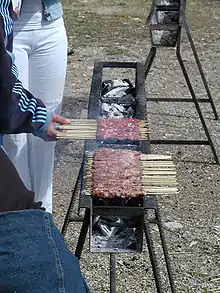 | |
| Type | Snack, street food |
|---|---|
| Place of origin | Italy |
| Region or state | Abruzzo, Molise |
| Main ingredients | Mutton or lamb |

Arrosticini are a class of traditional dishes of skewered grilled meat characteristic of Molisana and Abruzzese cuisine (from the Italian regions of Abruzzo and Molise).[1] Arrosticini (rustelle or arrustelle in the local dialects; also known as spiedini or spiducci) are typically made from mutton or lamb cut in chunks and pierced by a skewer. It is cooked on a brazier with a typically elongated shape, called furnacella, which resembles a gutter.
There are two main kinds of arrosticini: those made industrially, consisting of cubical chunks of meat with a side of 1 cm (0.4 inches) on skewers with a maximum length of 10 cm (4 inches); and those made by hand, for which the meat is cut with a knife in chunks of different sizes, alternated on the skewer with pieces of ovine fat. Arrosticini originate from the food consumed by shepherds and other inhabitants of the mountainous areas in Abruzzo within the villages of Castilenti, Civitella Casanova, Carpineto and Villa Celiera who were accustomed to eating even less refined food than hard sheep meat.
Arrosticini are often accompanied by slices of bread soaked in extra-virgin olive oil (pane 'onde). The traditional beverage accompaniment is Montepulciano d'Abruzzo wine. Traditionally, arrosticini are eaten by pulling the meat off the skewer piece by piece using one's teeth.
See also
- List of lamb dishes
- Satay
- Spiedie – an Italian-American dish descended from arrosticini
- Shish kebab
References
- ↑ Il Devoto-Oli 2014. Vocabolario della lingua Italiana, edited by Luca Serianni and Maurizio Trifone, Le Monnier, 2013.
